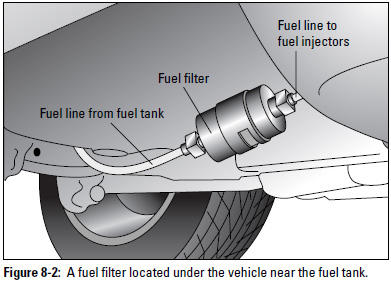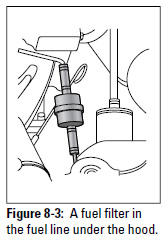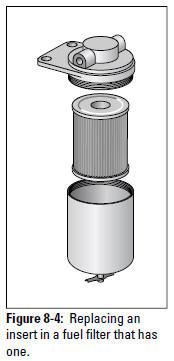Unless your vehicle suddenly starts to hesitate or run roughly, fuel filters on modern fuel-injected vehicles only need to be checked — and replaced, if necessary — during the tune-up inspections specified in your owner's manual. The likelihood of a fuel filter malfunctioning is significantly greater if you tend to ride around with an almost-empty fuel tank.
|
Why You Should Keep the Fuel Tank Full Because the space in the fuel tank above the fuel level is filled with air, and because air contains quite a bit of water vapor, the water in the air tends to condense on the sides of the fuel tank and elsewhere on cool mornings. This water vapor can rust the insides of a metal fuel tank, it can mix with the fuel in any tank — metal or plastic — and it can act in a variety of pesky ways to keep your vehicle from operating efficiently. If you keep your fuel tank well-filled, there's less room for air and therefore less water vapor hanging around. This is an excellent reason for not driving around until your fuel gauge reads "Empty." Another reason for making those extra trips to the gas station is that the rust formed by the water vapor in the air tends to sink to the bottom of the fuel tank. These sediments can do no harm as long as they're happily sloshing around in the bottom of the tank. But if you let the fuel level in the tank get too low, the fuel fed to your engine could be like the last bit of coffee in the bottom of the pot — full of sediment that tends to stick in the throat. Some fuel tanks have filters to prevent this junk from getting through to the engine, but the filters can get choked up if you consistently drive on an empty tank. |
If your vehicle starts to run roughly as soon as you fill it up with gas, contaminants in the fuel may have plugged up the filter. In that case, it should be replaced immediately. To decide whether you can do this job yourself, you need to know what type of fuel filter your vehicle has and whether you can tackle the job. Check your owner's manual or a service manual for your vehicle's make,model, and year to find the filter and see what's involved in changing it.
Deciding Whether to Change a Fuel Filter Yourself
Changing the filter on a fuel-injected vehicle can be tricky. On fuel-injected vehicles, you need to disable the fuel pump to relieve the pressure on the fuel lines, which may be secured to the filter with clamps, threaded fittings, or special quick-connect fittings. Lines with threaded fittings require a special flare-nut line wrench. Lines with special quick-connect fittings may require special tools to disconnect them. Ask the clerk at an auto parts store or the service department at your dealership which type of filter your vehicle has. If doing this infrequent job requires purchasing special tools, it's probably cheaper to have it done by a technician. If not, the first thing you need to do is find the filter.
Locating the Fuel Filter
Your owner's manual should show you where your fuel filter is and whether there's more than one on your vehicle. If it doesn't, ask someone in the service department at your dealership or consult a service manual for your vehicle'smake, model, and year. (Although it's a good idea to own one, you can usually find these manuals at your local library.)
If your engine has fuel-injection, your fuel filter is located somewhere in the high-pressure fuel line, either under the vehicle near the fuel tank (seeFigure 8-2) or under the hood in the fuel line near the engine (see Figure 8-3).

|
Some vehicles also have a fuel filter in the fuel pump as well as a filter screen inside the fuel tank. If they get blocked up, only a professional should deal with them.
Tip: On some vehicles, the fuel filter is found anywhere in the fuel line from the fuel tank to the fuel injectors and is held in place by metal clamps on either side of it. Some fuel filters on fuel-injected engines require special tools to disconnect the fuel lines in order to get to the filters.
Caution: Don't use a work light with an incandescent bulb when changing a fuel filter. Fuel that drips on the bulb can cause it to break and start a fire. Use a flashlight if you need to shed some light on the subject.

Replacing a Fuel Filter
Here are step-by-step instructions for changing a fuel filter. Before you get started, read them carefully and make sure that you want to do this job yourself.
1. Relieve the pressure in the fuel line before disconnecting it. To do so, you have to disable the electric fuel pump before you start the engine.
To disable the fuel pump, do the following:
- With the engine off, remove the fuel pump fuse from the fuse box (your owner's manual should show you where it is).
- Make sure that the parking brake is on and that the vehicle is in Park or Neutral, and then start the engine. It won't run very long after you start it up, but the pressure in the fuel lines will be reduced.
- Turn off the engine. With the fuel pump disabled, you're ready to disconnect the fuel lines from the filter.
2. Look at the old filter and the new one before disconnecting anything.
You should see an arrow stamped on both filters that shows in which direction the fuel flows through it. If the new one doesn't have an arrow on it, look to see in what direction the old filter is installed so that you can tell which end of the new filter goes where.
3. Remove whatever is holding the old filter in place.
4. Put the new filter on with the arrow facing toward the engine or in the same position as the old one was.
5. Replace whatever holds the filter in place, and make sure it's secure.
6. Replace the fuse for the fuel pump in the fuse box.
7. Make sure that the parking brake is on and that the vehicle is in Park or Neutral, and then start the engine and check for leaks around the filter.
Replacing an Insert in a Fuel Filter
If your vehicle has a fuel filter with an insert that can be replaced, follow Step 1 in the previous section to disable the fuel pump. Then open the cap on the filter, lift out the old insert, and drop in the new one facing in the same direction as the old one was (see Figure 8-4). Be sure to replace the cap securely. Then replace the fuse for the fuel pump, check to be sure the vehicle is in Neutral or Park with the parking brake on, start the engine, and check the filter for leaks.

From Auto Repair for Dummies, copyright © 2009 by Wiley Publishing, Inc., Indianapolis, Indiana. Used by arrangement with John Wiley & Sons, Inc.










